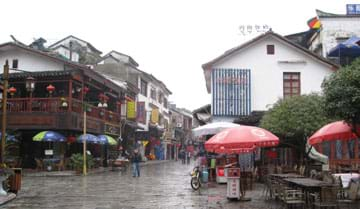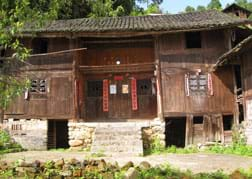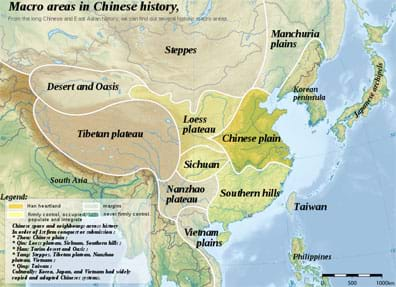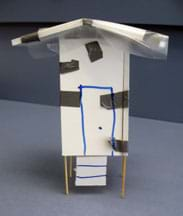Quick Look
Grade Level: 5 (4-6)
Time Required: 15 minutes
Lesson Dependency: None
Subject Areas: Science and Technology
NGSS Performance Expectations:

| 3-ESS2-2 |

Summary
Students learn about some of the different climate zones in China and consider what would be appropriate design, construction and materials for houses in those areas. This prepares them to conduct the associated activity(ies) in which they design, build and test small model homes for three different climate zones.Engineering Connection
Engineers design houses to shelter people from specific environmental conditions. Their objective is to help keep people comfortable in all weather and seasons, so they are safe and protected from windy, rainy, snowy, wet, dry, cold and/or hot weather. To design homes that are appropriate for the local climate, engineers must fully understand the unique characteristics of the climate, as well as the availability and suitability of the building materials and resources.
Learning Objectives
After this lesson, students should be able to:
- Explain why engineers design different types of homes in different locations (to meet the needs of various climates).
- Give several examples of different home designs engineers might use for different climates (such as thick walls for desert climates, peaked roofs for snowy areas, elevated foundations for tropical climates).
- Explain the wide range of building materials used to construct homes in different climates (to take advantage of local materials and labor).
Educational Standards
Each TeachEngineering lesson or activity is correlated to one or more K-12 science,
technology, engineering or math (STEM) educational standards.
All 100,000+ K-12 STEM standards covered in TeachEngineering are collected, maintained and packaged by the Achievement Standards Network (ASN),
a project of D2L (www.achievementstandards.org).
In the ASN, standards are hierarchically structured: first by source; e.g., by state; within source by type; e.g., science or mathematics;
within type by subtype, then by grade, etc.
Each TeachEngineering lesson or activity is correlated to one or more K-12 science, technology, engineering or math (STEM) educational standards.
All 100,000+ K-12 STEM standards covered in TeachEngineering are collected, maintained and packaged by the Achievement Standards Network (ASN), a project of D2L (www.achievementstandards.org).
In the ASN, standards are hierarchically structured: first by source; e.g., by state; within source by type; e.g., science or mathematics; within type by subtype, then by grade, etc.
NGSS: Next Generation Science Standards - Science
| NGSS Performance Expectation | ||
|---|---|---|
|
3-ESS2-2. Obtain and combine information to describe climates in different regions of the world. (Grade 3) Do you agree with this alignment? |
||
| Click to view other curriculum aligned to this Performance Expectation | ||
| This lesson focuses on the following Three Dimensional Learning aspects of NGSS: | ||
| Science & Engineering Practices | Disciplinary Core Ideas | Crosscutting Concepts |
| Obtain and combine information from books and other reliable media to explain phenomena. Alignment agreement: | Climate describes a range of an area's typical weather conditions and the extent to which those conditions vary over years. Alignment agreement: | Patterns of change can be used to make predictions. Alignment agreement: |
International Technology and Engineering Educators Association - Technology
-
Create solutions to problems by identifying and applying human factors in design.
(Grades
6 -
8)
More Details
Do you agree with this alignment?
State Standards
Colorado - Science
-
Examine, evaluate, and question information from a variety of sources and media to investigate how climates vary from one location to another on Earth
(Grade
8)
More Details
Do you agree with this alignment?
Worksheets and Attachments
Visit [www.teachengineering.org/lessons/view/cub_china_lesson02] to print or download.Pre-Req Knowledge
Familiarity with the concept of climates and that climates are different around the world.
Introduction/Motivation
(In advance, prepare computer projector or overhead transparencies to show students the attached Homes for Different Climates PowerPoint presentation. Its 13 slides cover the range of climate types found in China, the engineering design-build-test cycle, many photos of houses in China, and introduce the associated activity[ies].)
We've been learning about some of the environmental challenges in China, such as renewable vs. non-renewable energy and air quality. Another important environmental factor that engineers must take into account is climate.
What is a climate? (Listen to student suggestions.) Well, weather is an important part of defining the climate of a location. But, climate is more than today's weather conditions — rainy or snowy or cloudy or sunny. Climate is looking at the overall weather of a location over a long period of time. It is the average weather in a certain area over a number of years. Is an area generally moist or dry or cold or hot? Or what combination of these conditions are experienced regularly through the seasons? (Perhaps identify the characteristics of your local climate.) Areas that have similar climates are called climate zones.
What might be some different types of climates? (Listen to student suggestions; write different ones on the board; see Background section for more detail on the classification of different types.) Let's think of examples of these in the United States. (Review the characteristics of these climates and take student suggestions.)
Just as when engineers think about air quality and air pollution, or about how much or what types of energy people need to heat or cool their homes, they also must think about the local climate as they design homes and other buildings.
Besides knowing the expected year round weather conditions for the region, engineers must also consider what design strategies and housing materials are available and work best in that location.

Did you realize that homes are designed in a particular way so that they work best in certain climates? What might be some examples of this? (Have students think about steep roofs, flat roofs, domed igloos, thick walls, big windows, small windows, triple-paned windows, window locations, functional shutters, roof overhangs, breezeways, screened porches, basements, raised foundations, orientation to the sun, etc., as well as the common characteristics of homes in their climate.)
And not all climates have the same raw materials available for construction. How might this influence the types of construction and building materials used? (Have students think about log cabins, adobe houses, teepees, igloos, sod houses, stone barns, thatched roofs, lumber or steel or concrete construction, etc.)
So engineers must think about the climate conditions and the available construction materials. For example, it is useful to have a house raised up from the ground in very wet climates. How could this be done? If concrete blocks or big stones are not available, maybe bamboo poles or tree trunks could be used. Or if we wanted thick walls to keep out the cold winds or hot sun, but trees (logs and beams) are not available, maybe mud and straw are available to make adobe bricks.
Today we are going to learn about climate zones and climate in China, and then you are going to get the chance to work in teams as engineers to design, build and test your own model houses for specific climates in China — desert, tropical, or snowy.
China is a big country and has many different climate zones, so engineers must take climate into account when they are designing homes for people in China. (Proceed to show students the attached PowerPoint presentation. Then conduct the associated activity [ies].)
Lesson Background and Concepts for Teachers
Climate is defined as weather over a long period of time, and a climate zone is a region with the same climate. The Köppen climate classification system defines in great detail the world's climates, including five major climate types: moist tropical, dry, humid middle latitude, continental, and cold. China contains all these basic types.
- Moist tropical climates are known for high temperatures year round and for a large amount of year round rain.
- Dry climates are characterized by little rain and a huge daily temperature range. Two subgroups, are semiarid or steppe, and arid or desert.
- In humid middle latitude climates land/water differences play a large part. These climates have warm, dry summers and cool, wet winters.
- Continental climates can be found in the interior regions of large land masses. Total precipitation is low and seasonal temperatures vary widely.
- Cold climates are areas where permanent ice and tundra are always present. Only about four months of the year have above freezing temperatures.
These categories are further subdivided based on temperature and precipitation in different seasons, and then a third level of subdivisions for more climate variations. Names for different types of climates include tropical, rainforest, savanna, temperate, subtropical, desert, steppe (or grassland or prairie), chaparral (or forest or woodland or scrub), grassland, deciduous forest, taiga (or subarctic or Boreal), tundra and alpine (or mountain or high plateau). See the References for resources that provide more description as well as example locations of these various climates.

The large land mass of China has many different climate zones. Areas in China include mountains, plains, lowlands, deserts, islands, and subtropical areas (show students a map of China and/or see Figure 1). The eastern and western halves of the country are very different from each other, and climates within the country range from tropical to subarctic with wide variations in average precipitation and temperatures. The country has many beautiful mountains, including the Tian Shan ranges in western China.
The seven climate zones of China are quite different: The Northeast has cold winters and warm, humid summers, while the Southwest has high mountains, and mild winters. Central China has warm, humid summers and sometimes typhoons by the coastal areas. South China has very hot summers, and heavy rainfall, while the Western interior zone of China is an arid desert climate. Inner Mongolia has mountain ranges, semi-desert lowlands and an extreme continental climate. The Tibetan Plateau has extremely cold winters — it is the highest plateau in the world and extends into India.
In all climates, unique design strategies are employed to create houses that work best for the local environmental conditions. For example, making thick walls for insulation in severely hot climates; peaked roofs to shed heavy snow loads; raised foundations for perpetually wet or often flooding climates (and to catch cooling breezes under the house); partially underground sod-roofed homes for warmth in severe cold; temporary tent homes made of poles, hides, cloth and carpets for people that move seasonally; basements and root cellars for seasonal food storage and protection from tornados.
Not every climate has trees from which to build housing, but every climate has some local resources that can be used, everything from stones to bamboo to clay to sod to animal hides to snow to wool to dried grasses! Part of understanding and building in a certain climate is investigating its resources for housing materials. As an example, see the article about the design of a west African school, as described in the Additional Multimedia Support section.
To do a good job designing homes that work well in different climates, engineers must investigate and ask: What are the expected weather conditions for the region, year round? What design strategies might protect people from those weather conditions? What are available construction materials and labor?
Notes on the Associated Activities

In the associated activity, Construct and Test Roofs for Different Climates, student teams design, test and improve model homes for one of three Chinese cities — Harbin, Guangzhou or Urumqi — in three different climate zones. They act as engineers and create their own design strategies and techniques so their houses perform well in the snowy, tropical or desert climate conditions tested. As introduced in the attached PowerPoint presentation, Harbin is in the far north of China where it is quite cold, Guangzhou is located the south in a tropical climate, and Urumqi is in far western China in a drier climate. As part of the activity, students are provided with a sheet of background information including latitude, altitude, and average summer and winter temperatures for the three locations, and a worksheet. Some design tips for the students: elevated foundations and roofs that extend over the sides of the house for tropical homes; steep, strong roofs for homes in cold climates; and thick, insulated walls for desert climates. Encourage students to think about how their homes will be tested, and only create homes that are one story tall.
A second associated activity, A House for Me: Materials and Design for Different Climates, provides a similar design-build-test activity, with more focus on materials choice.
Associated Activities
- Construct and Test Roofs for Different Climates - Students design and build model houses that include design strategies suitable for specific climates. They test the models against various climate elements, and then re-design and improve them.
- A House for Me: Materials and Design for Different Climates - Students brainstorm and discuss the wide range of different types of materials used to build houses in various climates. They create small models of houses and test them in different climates.
Lesson Closure
Who can tell my why engineers design different homes for different climates? (Listen to student answers; correct and amend as necessary.)
What is important for engineers think about so they do a good job designing homes that work well in different climates? (The expected weather conditions for the region, year round. What design strategies might protect people from those weather conditions. What available materials and labor could be used to construct the houses.) What are some examples of how people in different cultures and locations create(d) homes with different design, construction and materials? What materials do/did they use? How do/did climate considerations shape the house designs? (Listen to student answers; correct and amend as necessary.)
If you were engineers designing homes for people in China, do you have ideas for you how might design safe and snug homes? Well, in our activity today, you have the chance to be engineers as you work in teams to design, build and test model homes for specific climates in China. You're in charge, so be creative, and have fun!
Vocabulary/Definitions
climate: The average weather in a certain area over a number of years.
climate zone: A region with the same climate.
Assessment
Pre-Lesson Assessment
Your House: Ask students the following questions and discuss as a class:
- What does your house look like?
- How does your house protect you from the weather?
- What are its design features that do this?
- What construction materials were used to make your house?
- How do certain materials protect you from the weather?
Post-Introduction Assessment
Write and Pass: Have each student label a piece of notebook paper with spaces for lines from 1-10. Instruct the students that after a signal from you (after roughly 10-20 seconds), they are to pass their papers to the next student and quickly write down one housing material, housing type, or distinctive housing feature that might be used in different climates. Each time the signal is given, everyone passes the papers on to the next person. After the end of the time, invite a few students to read back their lists.
Lesson Summary Assessment
Concept Juggle: Have students stand in a circle facing in and toss a ball to each other across the middle of the circle. Each time they toss the ball, have one student name a climate, and the next person name a environmental challenge that comes with that climate, and the next person name an engineering solution (such as a design strategy, construction technique or material choice) that addresses that issue. For example: rainforest > pouring rain > angled roof with deep overhangs to keep water off the sides of the house, or desert > high temperatures > thick walls made of mud bricks. Then start again with the next student naming a climate type, and so on. For a class of 30 students divide into two circles.
Homework Assessment
Think about My Home: Have students write one-page reports explaining the various design features of their homes, and why they think their homes were constructed the way they were. Why did the engineers who designed the home choose the materials they did? What elements of the home are related to the local climate? Now that you've lived in the house, do you have any suggestions for improvement? Include sketches or photographs to help explain. Have students present their short reports to the class.
Lesson Extension Activities
Have students bring in photographs or pictures of houses from magazines and talk about why they think each home was designed in its particular way. Can we figure out what climate they were designed for just by looking at the pictures?
Have students research homes in other cultures and times — log cabins, teepees, igloos, homes in the Amazon rainforest or the frozen northlands of Greenland. How did these different cultures and communities adapt to their specific locations? What materials did they use? How did climate considerations shape the house designs?
Bring in sheets, poles and ropes and have students work in teams to research and then build teepees in the schoolyard. Eat lunch in the teepees together and talk about this particular use of materials and how this home design suited the Native American people for their way of life.
Additional Multimedia Support
Have students read and then discuss an example in west Africa where a school was designed to work with the climate and built with local materials and labor to withstand weather conditions ranging from blazing sun to torrential showers. The designer, a native of the community, reverse engineered everything he was taught at school, using principles of heat to figure out natural cooling, and learning to design windows that would protect from the blazing sun but still offer ventilation. See "It Takes a Village," in the June 2011 issue of Fast Company magazine.
Subscribe
Get the inside scoop on all things TeachEngineering such as new site features, curriculum updates, video releases, and more by signing up for our newsletter!More Curriculum Like This

Students explore characteristics that define climatic regions. They learn how tropical, desert, coastal and alpine climates result in different lifestyles, clothing, water sources and food options for the people who live there.

Through an overview of some of the environmental challenges facing the growing and evolving country of China today, students learn about the effects of indoor and outdoor air pollution that China is struggling to curb with the help of engineers and scientists.

In this activity, students design and build model houses, then test them against various climate elements, and then re-design and improve them. Using books, websites and photos, students learn about the different types of roofs found on various houses in different environments throughout the world....
References
China. Atlapedia Online. Accessed July 13, 2011. (Information on location, geography, climate, people, demographics, religions, languages, history, economy, industry, etc.) http://www.atlapedia.com/online/countries/china.htm
Climate. China Culture.org. Accessed July 11, 2011. (General description of various climates in locations in China) http://www.chinaculture.org/library/2008-01/08/content_21794.htm
Climate (definition). Merriam Webster.com. Accessed July 11, 2011. http://www.merriam-webster.com/dictionary/climate
Geography of China. Last updated July 8, 2011. Wikipedia, The Free Encyclopedia. Accessed July 11, 2011. (Includes an assortment of photographs) http://en.wikipedia.org/wiki/Geography_of_China
Köppen Climate Classification. Last updated July 8, 2011. Wikipedia, The Free Encyclopedia. Accessed July 12, 2011. (Detailed description of this classification system, including example locations for each climate description) http://en.wikipedia.org/wiki/K%C3%B6ppen_climate_classification
Schaffner, Brynn. World Climate Zones. Blue Planet Biomes, West Tisbury Elementary School. Accessed July 11, 2011. (Good summary information on facts about climate, seasons, and Köeppen's climate classification system, including example locations for each climate description) http://www.blueplanetbiomes.org/climate.htm
What is a climate zone? Wise Geek, Clear Answers for Common Questions, Conjecture Corporation. Accessed July 11, 2011. http://www.wisegeek.com/what-is-a-climate-zone.htm
Copyright
© 2009 by Regents of the University of ColoradoContributors
Abigail T. Watrous (This material developed in part during Watrous' China Fulbright fellowship in 2009-10. Sincere thanks to the U.S. State Department and the Fulbright Program for their support.); Stephanie Rivale; Janet Yowell; Denise W. CarlsonSupporting Program
Integrated Teaching and Learning Program, College of Engineering, University of Colorado BoulderAcknowledgements
The contents of this digital library curriculum were developed under a grant from the Fund for the Improvement of Postsecondary Education (FIPSE), U.S. Department of Education and National Science Foundation GK-12 grant no. 0338326. However, these contents do not necessarily represent the policies of the Department of Education or National Science Foundation, and you should not assume endorsement by the federal government.
Last modified: February 25, 2020







User Comments & Tips